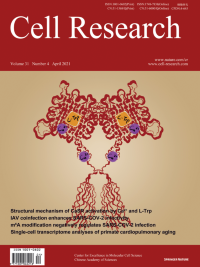
Advanced Search
Submit Manuscript
Advanced Search
Submit Manuscript
Volume 31, No 4, Apr 2021
ISSN: 1001-0602
EISSN: 1748-7838 2018
impact factor 17.848*
(Clarivate Analytics, 2019)
Volume 31 Issue 4, April 2021: 485-487
Overexpression of Kdr in adult endocardium induces endocardial neovascularization and improves heart function after myocardial infarction
Zhen Jiang1,2 , Zhengkai Lu1,2 , Shan Kou1,2 , Teng Feng1,2 , Yuanxin Wei1 , Zibei Gao1,2 , Defang Deng1,2 , Jufeng Meng1 , Chao-Po Lin1 , Bin Zhou1,2,3 , Hui Zhang1,*
1School of Life Science and Technology, ShanghaiTech University, Shanghai 201210, ChinaDear Editor,
Coronary artery disease is a leading cause of mortality and morbidity worldwide. Blockade of effective blood flow to heart muscles results in cardiac ischemia and myocardial infarction (MI).1 Many angiogenic factors are known to be elicited during MI, indicating a natural response of the heart to induce the formation of new coronary vessels in an attempt to revascularize the ischemic myocardium.2,3 However, coronary vascular endothelial cells (VECs) do not have sufficient angiogenic potential to effectively repopulate all ischemic regions, and clinical trials aiming at inducing revascularization through the delivery of pro-angiogenic molecules after ischemia have invariably failed.4 During development, a significant portion of coronary VECs in ventricular free walls and septum are reported to arise from endocardium during fetal and neonatal stages.5,6,7 Nonetheless, adult endocardium barely contribute to coronary VECs in homeostasis or after injuries such as MI.8 Finding new ways to promote neovascularization of adult endocardium offers important clinical insights into developing potential new therapeutic approach for treating ischemic heart diseases.
https://doi.org/10.1038/s41422-020-00436-y